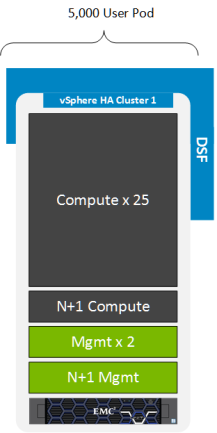Home > Integrated Products > XC Family > Guides > VDI Design Guide—Citrix Virtual Apps and Desktops on Dell EMC XC Family > File workload guidance
File workload guidance
-
The increased growth in the amount of data that is stored in file shares and user home directories across corporate IT environments in recent years has resulted in an increased focus on the need to better manage this unstructured data. As a result, many organizations are choosing to deploy dedicated file workload solutions with capabilities such as cloud file tiering and single file system namespaces across their IT infrastructure, including for file workloads in a VDI environment.
Dell EMC provides a number of file workload solutions for different types of file workloads.
The architectures that are shown in Figures 7 and 8 below show VDI management and compute environments sharing a vSphere HA cluster. This architecture is universally applicable across SDS environments that require access to dedicated file storage. It is also acceptable to configure these management and compute environments in separate HA clusters (see Architecture overview). In this scenario, each compute cluster and its associated management cluster should share a single file storage system, for example Unity, Isilon.
Dell EMC Unity
Dell EMC Unity storage is simple, unified all-flash and hybrid storage with hybrid cloud capabilities.
Dell EMC Unity is ideal for general purpose NAS/SAN mixed workload consolidation, smaller file workloads (including small to mid-sized VDI environments), and transactional databases.
The following figure shows an example of a 5,000-user VDI deployment using Dell EMC Unity storage for file shares.
Figure 7: 5,000-user pod on Dell EMC Unity

When deploying Dell EMC Unity in a VDI environment, Dell EMC recommends that you deploy a separate Dell EMC Unity storage system with a vSphere HA cluster or Pod. This structure provides the greatest scalability, resiliency, and flexibility when deploying and maintaining file services for the overall user pod. As unstructured data storage needs grow over time, the capacity of each Dell EMC Unity storage system can be scaled up independently with minimal user impact. You have the choice to deploy alternative architectures to the one suggested here, but you should carefully consider the tradeoffs.
The Dell EMC Unity All-Flash Unified Storage web page provides guidance about selecting an appropriate Dell EMC Unity storage solution for your file workload requirements.
Dell EMC Isilon file storage
Dell EMC Isilon storage is the industry's number one scale-out NAS solution for any file workload.
Isilon is ideal for a wide range of file workloads (including large-scale enterprise VDI environments requiring a single file system namespace), high performance computing (HPC), archiving, and infrastructure consolidation.
The following figure shows an example of a 20,000-user VDI deployment using DeIl EMC Isilon scale-out storage with a single namespace.
Figure 8: 20,000-user pod on Isilon

When deploying Dell EMC Isilon in a VDI environment, Dell EMC recommends that you deploy a separate Dell EMC Isilon storage system with a vSphere HA cluster or Pod. This structure provides the greatest scalability, resiliency, and flexibility when deploying and maintaining file services for the overall user pod. As unstructured data-storage needs grow over time, the capacity of each Dell EMC Isilon storage system can be scaled up independently with minimal user impact. In addition to scaling up each Isilon chassis, Isilon can also be scaled out using the OneFS operating system. This ability means that additional Isilon systems can be added to provide a single volume and namespace that all user pods in a datacenter can access.
As shown in the previous figure, Isilon OneFS can be scaled out as the VDI environment grows. You can choose to deploy alternative architectures to the one suggested here, but you should carefully consider the tradeoffs.
The Dell EMC Isilon web page provides guidance about selecting an appropriate Dell EMC Isilon storage solution for your file workload requirements.
